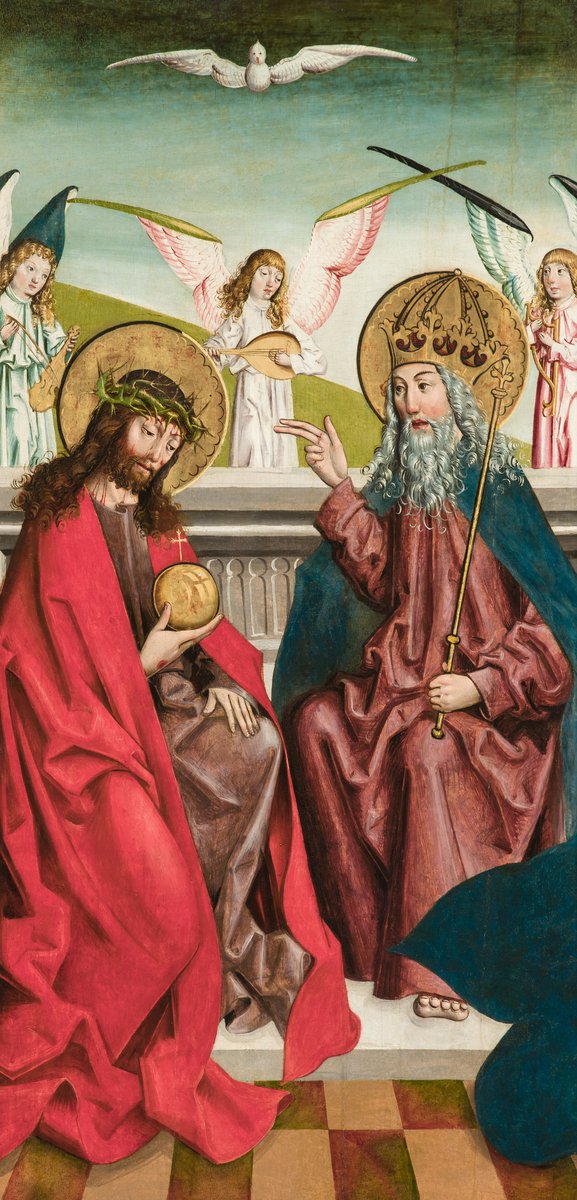
Christ is seated at the right hand of the Father. Panel from the left stationary wing of the high altarpiece of the Church of Saint John the Baptist in Kisszeben (today Sabinov, Slovakia)
Old Hungarian Collection
| Artist | |
|---|---|
| Date | 1471 |
| Object type | panel painting |
| Medium, technique | oil-egg tempera, gilt, transferred onto a new panel |
| Dimensions | image: 137 × 107 cm |
| Inventory number | 52.645 |
| Collection | Old Hungarian Collection |
| On view | Hungarian National Gallery Building D, Ground Floor, Church Adornments – Gothic Art in the Hungarian Kingdom, 1300 – 1500 |
The modestly talented painter of the Altar of the Holy Trinity in Mosóc may have been connected with the now destroyed altar art of Buda by the means of his employer. On the lower edge of the throne of the Heavenly Father, the artist has placed his (her?) monogram, G H, and the date 1471 between the letters. Leaning against the stone steps of the throne are the coats of arms, identifiable as bearing the insignia of János Ernuszt. János Ernuszt was a well-known officer and treasurer of King Matthias I, who was appointed lord lieutenant of Turóc county in 1470. The altarpiece, now in our collection, was ordered from a local master when Ernuszt was already in office, for the parish church of one of the county’s main towns. It was probably due to Ernuszt’s influence that the artist painted the Holy Trinity using Dutch iconography: the Father holding before him his Son on the cross and the Dove of the Holy Spirit hovering between them. The movements of the angels pulling aside the curtains on the tent echo the gesture of opening the wings on the altar.
Genthon, István, A régi magyar festőművészet, Pestvidéki Nyomda, Vác, 1932.
Radocsay, Dénes, A középkori Magyarország táblaképei, Akadémiai Kiadó, Budapest, 1955.
A Magyar Nemzeti Galéria régi gyűjteményei, Corvina Kiadó, Budapest, 1984.
Ungarische Nationalgalerie Budapest: Alte Sammlung, Corvina Kiadó, Budapest, 1984.
The Hungarian National Gallery: The Old Collections, Corvina Kiadó, Budapest, 1984.
Mojzer, Miklós – Urbach, Zsuzsa, Bott, Gerhard (ed.), Meisterwerke europäischer Malerei aus ungarischen Museen: Ausstellung, Germanisches Nationalmuseum; Electa; Thyssen-Bornemisza Collection, Nürnberg; Milano; Lugano, 1985.
Capolavori dei musei ungheresi: Collection Thyssen-Bornemisza, Thyssen-Bornemisza Collection, Electa, Lugano, Milano, 1985.
Török, Gyöngyi, Gótikus szárnyasoltárok a középkori Magyarországon, Kossuth Kiadó, Magyar Nemzeti Galéria, Budapest, 2005.
Matthias Corvinus, the King: Tradition and renewal in the Hungarian Royal Court, 1458 – 1490, Budapesti Történeti Múzeum, Budapest, 2008.
Hunyadi Mátyás, a király: Hagyomány és megújulás a királyi udvarban, 1458-1490, Budapesti Történeti Múzeum, Budapest, 2008.
Borchert, Till-Holger – Urbach, Zsuzsa – Török, Gyöngyi, van Calster, Paul (ed.), Van Eyck bis Dürer 2010: Altniederländische Meister und die Malerei in Mitteleuropa, Belser, Stuttgart, 2010.
A restaurálás művészete: kiemelkedő restaurálások a Magyar Nemzeti Galériában 1957–2011, A Magyar Nemzeti Galéria kiadványai 2014/3, Magyar Nemzeti Galéria, Budapest, 2014.
This record is subject to revision due to ongoing research.